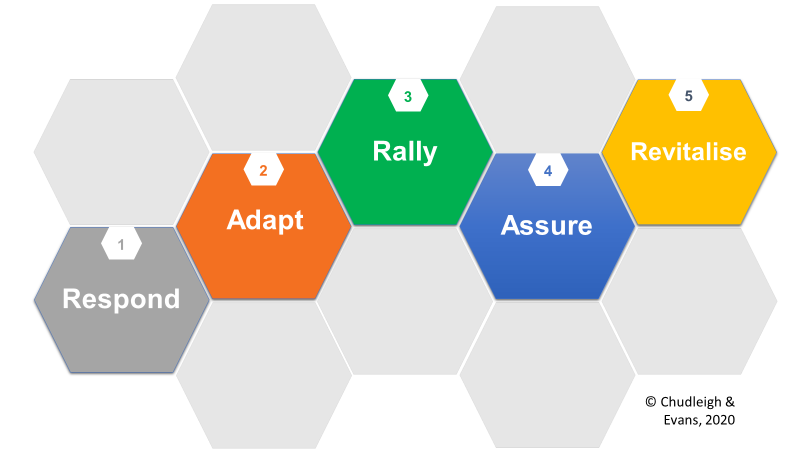Over recent weeks, we have supported leaders through the current crisis and the constant questions have been: How can we best support our people through times of crisis? What do we say and what should we do to navigate something we haven’t experienced before?
Our perspective, after much careful thought, is to be you, but better!
Indeed, in many ways, to switch leadership styles, particularly to one that is more controlling or directive at a time of uncertainty for everyone, is highly likely to be counterproductive.
So, we searched through our knowledge and experience of helping organisations through transition and deliberated over relevant, evidence-based approaches that could be shared. Yet we concluded that the leadership qualities that we have advocated over recent years are equally valid at times of crisis but there is a caveat – the need for a far more deliberate and considered application of emotional agility.
As one might expect from business psychologists, we have developed not one, but two frameworks to help guide our leaders and put into context the challenges of leaders at the present moment.
The first framework highlights the ‘why’ and the ‘what’ of leadership and attempts to illustrate how a shift to focusing on the immediate and short term can provide much needed clarity for your teams. Accepting this current situation may not be about effecting major change; the type where a transformative vision is called for is crucial to crafting a message that is honest and easily understood.
The second framework highlights the ‘how’ – how best to communicate and how to use our emotional intelligence to sustain and build our relationship with our team members in a way that enables us all to thrive in challenging circumstances.
So, what should leaders be focusing on as organisations transition through a difficult period?
The leadership framework proposed for use during transition of your business under crisis, is configured of five phases. Each phase is not discrete and in practice, they will overlap. Indeed, they may not be linear as the team or organisation receives new insights and reflects on learning, which moves us forward or back in our understanding of a situation.
In our recent discussions with leaders, they see teams might indeed transition from one phase to another more quickly or slowly than others. This may be dependent on where they sit in your organisation, closer to the decision making or closer to the customer?
Either way, this simple framework is offered purely as a way of considering where a team may be in their transition and in their understanding, and therefore what leadership approach and key messaging would be helpful for them at this time.

The five phases in the first framework are:
- Respond: The ‘emergency’ presents and we, as leaders, develop an initial response which does not seek to provide certainty, but can provide much needed short-term clarity. During this phase, leaders will be finding the facts for an evidence-driven response; ensuring health and well-being is known to be paramount and communicating with humanity about how the organisation will respond. It would help to establish a cohesive guiding coalition who will support your leadership approach and messaging.
2. Adapt: People need an opportunity to assess, find their feet and determine the agility required to deal with new circumstances. Leadership focus should be on protecting safety and well-being; creating new certainties or rather, probabilities, and importantly increasing opportunities for greater autonomy. Any activity that could enhance trust will be helpful long term, so beware that micromanagement doesn’t conceive a lack of trust in this early phase.
3. Rally: As new arrangements continue and evolve, the right rallying cry, that cuts out noise and helps people focus on a short-term priority, can galvanise and energise your teams behind a ‘temporary’ common purpose.
4. Assure: Novelty and uncertainty can lead to a lack of confidence across the teams, just at a time when we may need them to be at their most creative or taking more risks. But the right stories and examples of local heroes, doing a great job can remind us of our inherent strengths and capacity to succeed.
Our confidence in our individual and collective ability to do good things in difficult environments is boosted by stories of success. Teams that understand their impact believe they are winning and have the capacities to do even better are likely to continue to invest and engage deeply.
5. Revitalise: And as we prepare to shift into another phase, we must acknowledge that there is no going back. However, recent research into post traumatic growth suggests that we can emerge stronger from difficult situations if we take the time to consider what opportunities and benefits came from our struggles. Our people will have changed through this experience – they will need different support to embrace their resilient, brilliant best.
We explore ‘how’ leaders should behave in each phase in a follow up blog, but we would love to hear your insights, comments and views on this observational framework.
If you would like to explore further or to discuss your leadership needs, please contact us:
Sally Evans | Paul Chudleigh
sally@performandgrow.com / Paul@PDCConsultingLtd.onMicrosoft.com
Sally and Paul are both Business Psychologists working in the field of organisational development, in the UK and overseas
